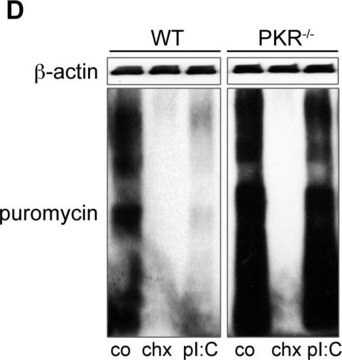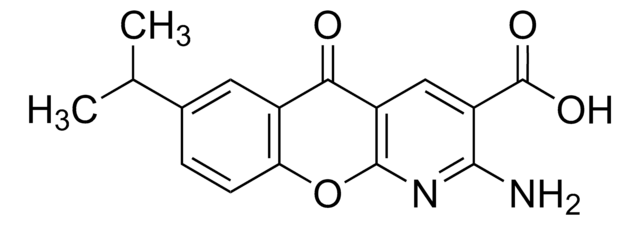540222
Puromycin, Dihydrochloride
Puromycin, Dihydrochloride, CAS 58-58-2, is An aminonucleoside antibiotic that inhibits protein synthesis by blocking the translation step and causes premature release of nascent polypeptide chains.
Synonyme(s) :
Puromycin, Dihydrochloride
About This Item
Produits recommandés
Niveau de qualité
Essai
≥98% (TLC)
Forme
solid
Fabricant/nom de marque
Calbiochem®
Conditions de stockage
OK to freeze
desiccated
Couleur
white to off-white
Solubilité
methanol: 20 mg/mL
water: 50 mg/mL
Conditions d'expédition
ambient
Température de stockage
−20°C
InChI
1S/C22H29N7O5.2ClH/c1-28(2)19-17-20(25-10-24-19)29(11-26-17)22-18(31)16(15(9-30)34-22)27-21(32)14(23)8-12-4-6-13(33-3)7-5-12;;/h4-7,10-11,14-16,18,22,30-31H,8-9,23H2,1-3H3,(H,27,32);2*1H/t14-,15+,16?,18+,22+;;/m0../s1
Clé InChI
MKSVFGKWZLUTTO-USYAMCSGSA-N
Description générale
Actions biochimiques/physiologiques
protein synthesis
Avertissement
Reconstitution
Autres remarques
Constam, D.B., et al. 1995. J. Biol. Chem.270, 26931.
Wirth, M., et al. 1994. J. Virol.68, 566.
Claeyssens, S., et al. 1993. FEBS Lett.315, 7.
Hechler, U., et al. 1993. Biochem. Biophys. Res. Commun.194, 1305.
Kaufman, S.H., et al. 1993. Cancer Res.53, 3976.
de la Luna, S. and Ortín, J. 1992. Methods Enzymol.216, 376.
Kalpaxis, D.L. and Drainas, D. 1992. Arch. Biochem. Biophys.300, 629.
Shipston, M.J. and Antoni, F.A. 1992. Biochem. Biophys. Res. Commun.189, 1382.
Informations légales
Mention d'avertissement
Warning
Mentions de danger
Conseils de prudence
Classification des risques
Acute Tox. 4 Oral
Code de la classe de stockage
11 - Combustible Solids
Classe de danger pour l'eau (WGK)
WGK 3
Point d'éclair (°F)
Not applicable
Point d'éclair (°C)
Not applicable
Certificats d'analyse (COA)
Recherchez un Certificats d'analyse (COA) en saisissant le numéro de lot du produit. Les numéros de lot figurent sur l'étiquette du produit après les mots "Lot" ou "Batch".
Déjà en possession de ce produit ?
Retrouvez la documentation relative aux produits que vous avez récemment achetés dans la Bibliothèque de documents.
Les clients ont également consulté
Notre équipe de scientifiques dispose d'une expérience dans tous les secteurs de la recherche, notamment en sciences de la vie, science des matériaux, synthèse chimique, chromatographie, analyse et dans de nombreux autres domaines..
Contacter notre Service technique








